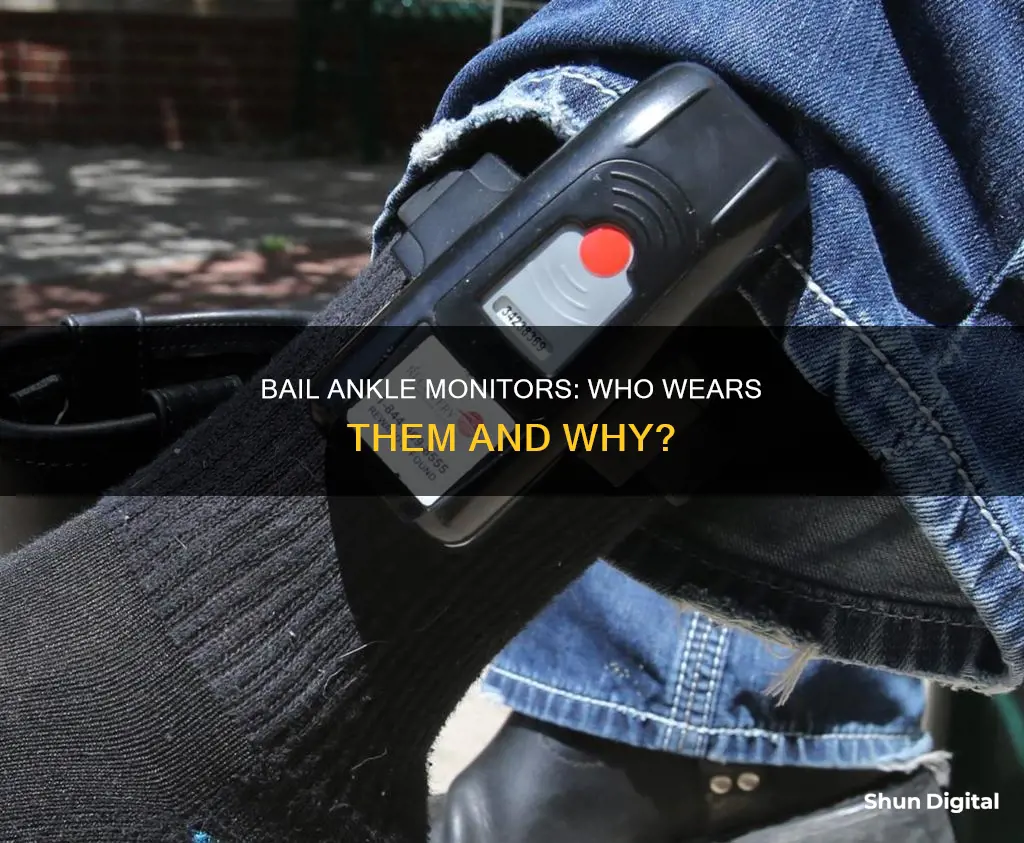
Ankle monitors are used as a condition of bail to track an individual's location and movements. They are typically used for people who are considered a danger to the community, those involved in domestic violence cases, or those deemed a flight risk. The device helps ensure that the accused adheres to specific rules and regulations set by the court, such as sticking to a specific area, avoiding certain people, or adhering to a curfew. While not everyone on bail is required to wear an ankle monitor, it can be a way to reduce bail amounts and provide an alternative to pre-trial detention.
| Characteristics | Values |
|---|---|
| Who wears ankle monitors? | People who are considered a danger to the community, people involved in domestic violence cases, or those the court views as a flight risk. |
| When are ankle monitors worn? | When the wearer is out on bail, or as a condition of parole or probation. |
| Why are ankle monitors worn? | To ensure the wearer doesn't get into more trouble, to reduce the risk of bail bond forfeiture, to make tracking runaways easier, and to ensure attendance at court proceedings. |
| How do ankle monitors work? | They are GPS-enabled devices that track the wearer's location and transmit a signal to a base unit, usually located in the home. If the wearer exits a designated area, the device vibrates and emits a loud tone. If the wearer doesn't return to the designated area, the authorities are alerted. |
| What are the consequences of not wearing an ankle monitor? | If the court sets wearing an ankle monitor as a condition of release, refusing to wear one will result in remaining in jail while awaiting trial. |
What You'll Learn

Ankle monitors are a condition of bail for those deemed a flight risk
Ankle monitors are sometimes used as a condition of bail for those deemed a flight risk. While not everyone on bail will have to wear an ankle monitor, they are typically reserved for people who are considered a danger to the community, those involved in domestic violence cases, or those the court views as likely to flee.
Ankle monitors are used to track an individual's movements and location while they are free on bail. They are GPS-enabled devices that are fitted to the lower leg, just above the person's ankle. These devices monitor the wearer's location and send real-time data back to the court or monitoring agency. If the individual wanders outside the approved geographic area, the monitoring agency is alerted, and additional steps may be taken, including revoking bail.
In some cases, ankle monitors can be used as a way to reduce bail amounts. By agreeing to wear an ankle monitor, individuals may be able to negotiate lower bail fees with the court. This is because ankle monitors provide an assurance to the court that the accused will not flee and will adhere to the conditions of their release. Additionally, ankle monitors can help individuals quickly return to their daily routines, including going back to work, which can assist in generating income to pay bail bond fees.
Ankle monitors are also used in situations beyond bail conditions. They can be employed for house arrest, alcohol monitoring, or on individuals who are out on parole. In some cases, they are even used by high schools to monitor truant students, although this may be considered excessive. Overall, ankle monitors are seen as a cost-effective alternative to incarceration, saving money for both the government and taxpayers.
LED vs LCD: Battle of the Glare
You may want to see also

They are used as an alternative to jail time for low-risk offenders
Ankle monitors are often used as an alternative to jail time for low-risk offenders. They are typically worn by individuals on probation or parole, or those awaiting trial. This allows them to continue living in their communities, maintaining their jobs, and supporting their families while serving their sentences.
Ankle monitors are seen as a more humane alternative to incarceration, allowing individuals to live at home and move about more freely than they would in prison. They are also a more cost-effective option for the government, as it is less expensive to monitor someone in the community than to keep them in jail or prison. Additionally, the offender can continue to work, which makes it easier for them to pay off any fines or debts they may have incurred.
However, ankle monitors are not without their drawbacks. For one, individuals are often required to pay for the cost of the device and its operation, which can be a significant financial burden. There may also be strict rules and regulations that come with wearing an ankle monitor, and any violation of these rules can result in additional penalties or even imprisonment. The devices can also be uncomfortable and cause skin irritation.
Ultimately, while ankle monitors can be a viable alternative to jail time for low-risk offenders, they should be used with discretion, taking into account the offender's risk of reoffending and the nature of the crime.
Removing Omen Monitor Stand: A Step-by-Step Guide
You may want to see also

They can be used to reduce the cost of bail
Ankle monitors are an increasingly popular alternative to cash bail, with the number of people under electronic supervision increasing by 140% between 2005 and 2015. They can be used to reduce the cost of bail, as the fees associated with them are often lower than the cost of bail.
For example, if bail is set at $5,000 and the bail bond service charges a 15% fee, that's an additional non-refundable charge of $750. However, if the individual agrees to wear an ankle monitor, the court may reduce the bail amount. In this scenario, if the bail is halved to $2,500, the bail bond fee would be $250, plus the cost of the ankle monitor.
The cost of an ankle monitor includes an installation fee plus a daily monitoring fee, which varies by firm. The daily fees are typically between $5 and $35 per day, and these fees can sometimes be negotiated with the court. This means that it can take months for the total cost to reach the original bail amount.
In addition to the financial benefits, ankle monitors can also provide individuals with the opportunity to continue their daily lives while awaiting trial. They can return to work, earn an income, and spend time with their families. This is especially beneficial for those who may not be able to afford to lose their jobs or wages due to a prolonged stay in jail.
While ankle monitors can reduce the cost of bail, it is important to note that they also come with certain restrictions on movement and location, which individuals must adhere to in order to avoid additional penalties or jail time.
Removing CRT Monitor Stands: Pros, Cons, and Practicalities
You may want to see also

They are used in serious crime cases, such as murder
Ankle monitors are used as an alternative to pre-trial detention or as a condition of probation. They are often used in serious crime cases, such as murder, sexual assault, or major drug offenses. In these cases, courts may require the defendant to wear an ankle monitor as a condition of bail or parole. For instance, if a court considers an individual a flight risk, the judge may order them to wear an ankle monitor while out on bond. Ankle monitors are typically used to ensure that the accused does not leave a designated area and to monitor their compliance with court-ordered conditions, such as maintaining sobriety.
The use of ankle monitors in serious crime cases provides several benefits. Firstly, it serves as a deterrent, helping to prevent individuals from committing similar offenses or violating the terms of their release. Secondly, it offers an alternative to incarceration, which can be particularly detrimental to individuals with substance abuse issues. Ankle monitors allow these individuals to avoid prison and seek treatment while being monitored to ensure they remain sober. Additionally, ankle monitors provide a financial benefit to the state and the accused. They are more cost-effective for states than incarcerating low-level offenders, and they can also help reduce bail amounts for the accused by providing an incentive for courts to lower bail or waive it altogether.
While ankle monitors are commonly used in serious crime cases, they are not mandatory for everyone on bail. The decision to impose an ankle monitor as a condition of bail is made by the court and is based on various factors, including the severity of the crime, the individual's criminal history, and whether they are deemed a danger to the community or a flight risk.
Ankle monitors have become an integral part of the justice system, offering a way to balance public safety with the need for alternative sentencing options. By utilizing ankle monitors, courts can hold individuals accountable while providing them with the opportunity to remain in their communities and access treatment or other support systems.
Setting Up Floor Monitors: A Guide to Hearing Yourself
You may want to see also

They are used for repeat offenders
Ankle monitors are used as an alternative to prison, allowing individuals to remain in the community while serving their sentences. They are typically used for people on probation or parole, or those awaiting trial. Courts may also use ankle monitors as a condition of bail or parole for repeat offenders. This provides an extra layer of supervision to prevent them from committing further offences.
Repeat offenders may be required to wear an ankle monitor if they have a history of reoffending or have violated bail or parole terms in the past. The monitor helps to ensure they do not violate the terms of their sentence, such as maintaining sobriety or staying within a certain geographical area. For example, in cases of domestic violence, an ankle monitor can be used to ensure the offender stays away from the victim.
Ankle monitors are also used to deter repeat behaviour. They can track an individual's movements and location using GPS technology, sending alerts to the relevant authorities if the person wanders outside of a designated area. This helps to hold offenders accountable and promotes attendance at court proceedings.
In addition, ankle monitors can be used as a way to reduce bail amounts. By agreeing to wear an ankle monitor, an individual promises the court that they will not run away, increasing the chance of getting a lower bail price or even no bail at all. However, failure to wear an ankle monitor could result in higher bail.
It is important to note that ankle monitors are not always comfortable to wear and can cause skin irritation. They are also subject to strict rules and regulations, with any violation resulting in additional penalties or traditional imprisonment.
Hooking Up an RX 580: A Step-by-Step Guide
You may want to see also
Frequently asked questions
No. Ankle monitors are usually reserved for people who are considered a danger to the community, people involved in domestic violence cases, or those the court views as a flight risk.
Ankle monitors are used to track the location of the person wearing them and to ensure they stay within certain boundaries set by the court. They can also be used to detect alcohol consumption.
Yes, you can refuse to wear an ankle monitor, but this may result in remaining in jail until your court date.







